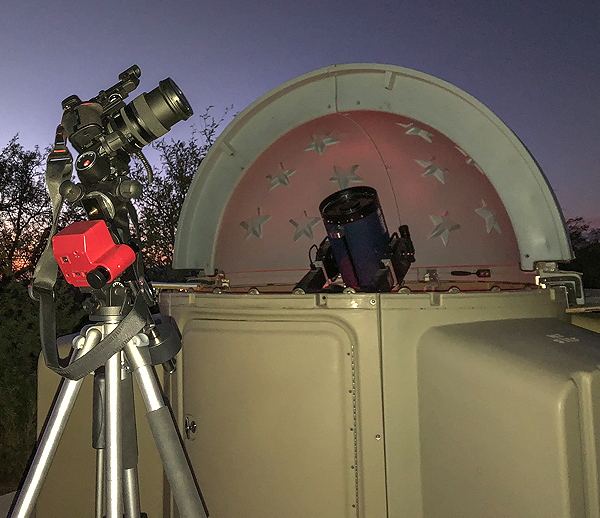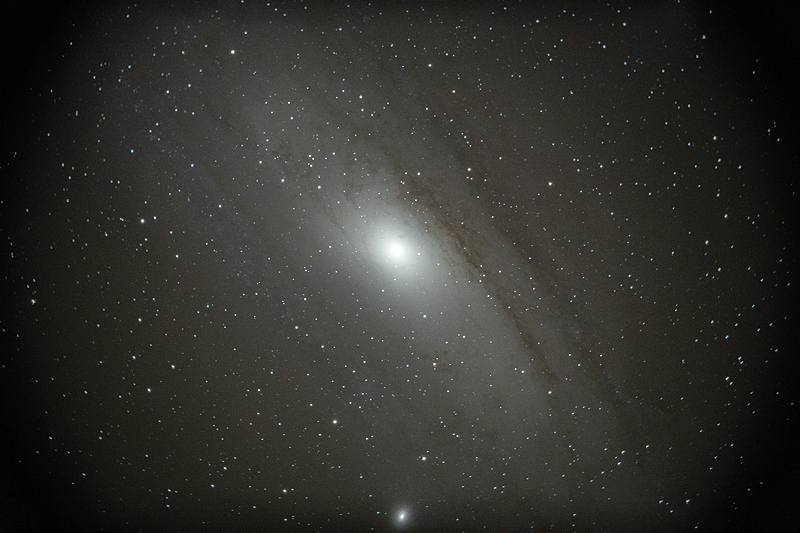SkyTracker Pro M31 & M33;
Extragalactic Supernova Project M31 & M33
Posted: 9 October 2018
Clouds from an approaching low pressure system began arriving mid-morning on Saturday, 6 October 2018, with the sky becoming mostly cloudy by late afternoon. Rain arrived on Sunday, 7 October. Received 0.32". Cloudy skies continued on Monday, 8 October, but the sky was mostly clear by sunset.
|
Open: Monday, 8 October 2018, 1812 MST Temperature: 68°F |
Session: 1288 Conditions: Mostly clear |
Equipment Used:
12" f/8 LX600 w/StarLock
2" 24mm UWA eyepiece
Focal Reducer
SkyTracker Pro
Camera:
D850 DSLR
Upon arriving at the observatory I set up a live trap in order to try to capture a packrat. I then set up the SkyTracker Pro with the D850 DSLR and 24-70mm lens on the observatory patio.

1836 MST: LX600 ON, StarLock OFF, High Precision OFF.
By this time the planet Venus was not visible. Viewed Jupiter and 4 moons, 102X. The moon Io was about to begin a transit of the planet's disk. Then viewed Saturn and Mars, 102X.
1845 MST: High Precision ON.
Viewed M31 (Andromeda Galaxy), 102X. The nucleus and its companion galaxy M32 were visible against the bright twilight sky.
1915 MST: viewed M33 (Triangulum Galaxy), 102X.
1918 MST: polar aligned the SkyTracker Pro. In order to get both M31 and M33 galaxies in the D850 DSLR field-of-view at a focal length of 70mm I had to place the camera in this position:

This is a tracked photo of M31 (left) and M33 (right), f/2.8, 30 seconds, ISO 12800, FL 70mm, cropped from the full-frame image:

Mouseover or tap on image for labels
1939 MST: ended SkyTracker Pro sky imaging.
2000 MST: began preparing to image M31 and M33 with the 12" telescope for my Extragalactic Supernova Project. Mounted the D850 DSLR at prime focus + focal reducer, focused on the star Mirach, and locked the primary mirror. 2009 MST: StarLock ON.
Due to the apparent size of M31 and M33 and their brightness, I did not use my normal galaxy exposure time (5 minutes) for the images. For M31 I also did three images, one centered on the nucleus and the others with the nucleus off-center. These are the StarLock autoguided images, 1 minute, ISO 6400, White Balance 5000K for M31, and 2 minutes, ISO 6400, White Balance 5000K for M33.
M31 (Andromeda Galaxy)



M33 (Triangulum Galaxy)

2033 MST: StarLock OFF.
Removed the DSLR and focal reducer. Viewed M33, 102X.
2043 MST: viewed NGC157 (galaxy), 102X. I plan to image this galaxy on the next session.
2047 MST: LX600 OFF.
|
Close: Monday, 8 October 2018, 2058 MST Temperature: 52°F |
Session Length: 2h 46m Conditions: Clear |
Comments are welcome using Email. Twitter users can use the button below to tweet this report to their followers. Thanks.
Cassiopeia Observatory Home Page
Copyright ©2018 Michael L. Weasner / mweasner@me.com
URL = http://www.weasner.com/co/Reports/2018/10/09/index.html
